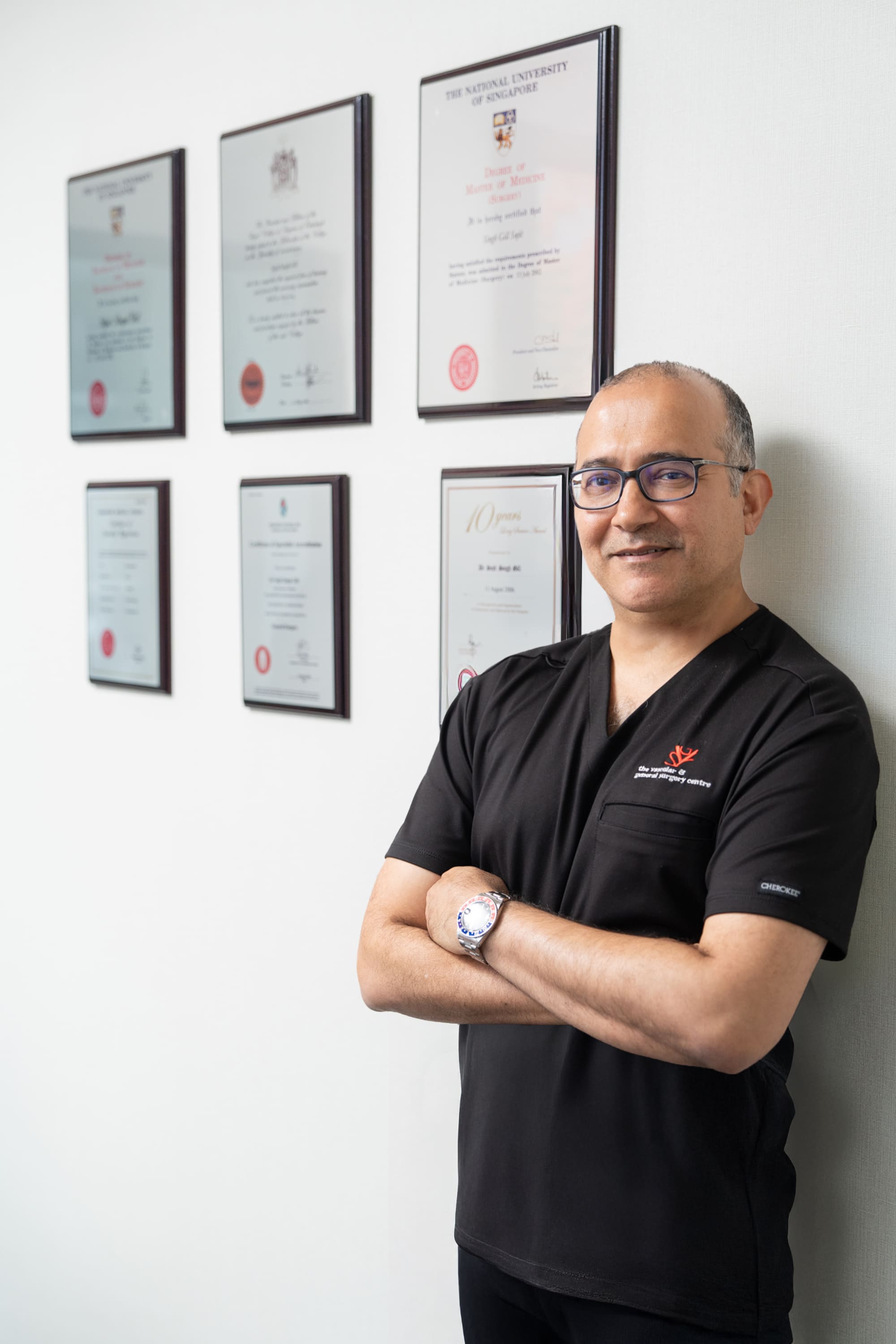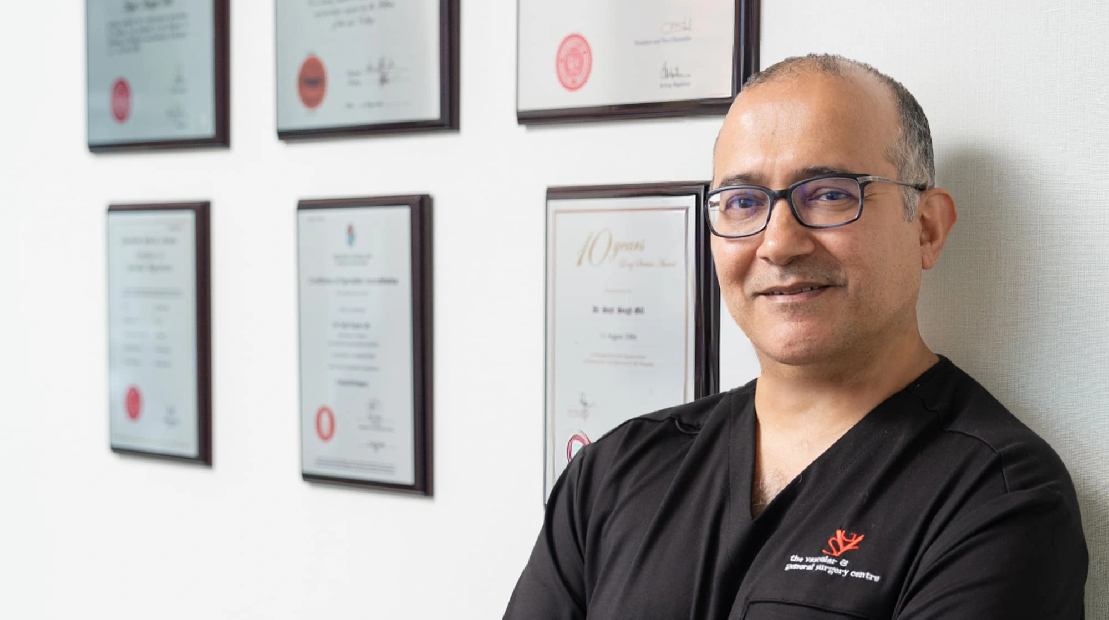
For a consultation, please contact us at +65 6736 2302 or fill up the form below and we will get back to you as soon as possible

For a consultation, please contact us at +65 6736 2302 or fill up the form below and we will get back to you as soon as possible

Dr Sujit Singh Gill
Consultant Vascular & General Surgeon
MBBS (Singapore), MMed (Singapore), FRCS (Edinburgh)

Varicose veins are enlarged, twisted blood vessels that bulge beneath the skin, often forming rope-like patterns most noticeable on the legs and ankles. In healthy veins, tiny valves keep blood flowing steadily back towards the heart, even against the pull of gravity. When these valves weaken or fail, blood can flow backwards and collect within the vein. This pooling increases pressure, causing the vessel walls to stretch and creating the distinctive blue or purple bulges associated with varicose veins.
Varicose veins most often develop in the lower limbs, where gravity and increased pressure place extra strain on the veins. They commonly appear in:
Varicose veins are sometimes dismissed as a cosmetic concern, but they can also bring discomfort—especially for people who spend long hours standing or sitting at work, such as nurses, teachers, or retail staff. Common symptoms include:
- They appear dark blue, purple, or sometimes greenish.
- Often worse after standing or sitting for extended periods.
- Symptoms that intensify after physical activity or prolonged immobility.
- Caused by irritation and inflammation linked to poor vein function.
- Beginning with bronze patches and, if untreated, progressing to hyperpigmentation, dermatitis, or even ulcers.
Varicose vein symptoms often stem from several factors, such as:
- Valves may deteriorate from age, genetic factors, or constant strain.
- Limited movement reduces the natural pumping action that helps blood return to the heart.
- Excessive pressure stretches vein walls, causing them to lose elasticity.
In most cases, varicose veins can be identified through a simple physical examination. To confirm the diagnosis and assess severity, doctors may also recommend imaging tests such as:
A detailed, non-invasive test that evaluates vein structure and blood flow, while detecting venous insufficiency and blockages.
Traditional Doppler studies use sound waves to detect blood flow abnormalities and valve dysfunction. While less comprehensive than duplex scanning, this technique remains valuable for initial screening and monitoring treatment response. In complex cases, additional imaging may be used to guide treatment planning.
If left untreated, varicose veins may lead to more serious complications, including:
- Open sores that form when prolonged vein pressure damages the skin.
- Although usually manageable with direct pressure, significant blood loss sometimes necessitates surgical intervention.
- This occurs when blood clots form in varicose veins, causing inflammation, pain, and potential extension into deeper venous systems.
- Untreated blood clots can travel to the lungs, causing pulmonary embolism, which is a potentially fatal condition.
Although some people may be more prone to varicose veins, healthy lifestyle habits can greatly lower your risk.
- Activities like walking and swimming strengthen calf muscles to support circulation.
- Take short breaks to move around, and rest your legs in an elevated position to improve circulation.
- This reduces hydrostatic pressure on leg veins, decreasing the likelihood of valve dysfunction and vein dilation.
- Provides external support for weakened vein walls, particularly beneficial for individuals with occupational or genetic risk factors.
These advanced treatments help restore healthy circulation and relieve common symptoms like heaviness, swelling, and discomfort. Unlike traditional vein stripping—which often requires hospitalisation and a longer recovery—laser and RFA therapies are minimally invasive, performed on an outpatient basis, and use only tiny incisions. Most patients can walk out the same day and enjoy a faster return to their usual activities with minimal downtime.
Endovenous laser therapy, often shortened to EVLT, is a minimally invasive procedure used to treat varicose veins. Instead of surgically removing the vein, this technique uses focused laser energy to seal it shut from the inside.
During EVLT, a thin laser fibre is inserted into the affected vein through a small incision, guided precisely with ultrasound. Once correctly positioned, the laser delivers controlled heat to the vein wall. This energy damages the inner lining, causing the vein to collapse and seal shut. Over time, the treated vein transforms into scar tissue and gradually fades, while healthy surrounding veins take over normal blood flow.
EVLT is recognised for being safe, effective, and well-tolerated, particularly for patients experiencing venous reflux or symptomatic varicose veins. Compared to traditional vein stripping, it offers a lower risk of complications and a faster recovery, often allowing patients to resume normal activities quickly.
Radiofrequency Ablation
Chemical ablation has been available for some time, but is gaining more interest with the introduction of Clarivein. Clarivein is a device that irritates the inner lining of the vein with a rotating metal tip and injects a chemical at the same. The combination of these two irritative mechanisms results in very effective vein closure with minimal discomfort. Clarivein is offered at The Vascular & General Surgery Centre.
Complications are minor. Bruising is common but will always resolve within 2-3 weeks. Small areas of numbness occurs in about 7% of patients but most resolve with time.
At our clinic, our vascular specialists provide comprehensive care for all stages of varicose veins. Leading our team, Dr Sujit Singh Gill, a consultant vascular and general surgeon with 25 years of experience, focuses on minimally invasive treatments for venous disorders. His extensive training in Singapore, Australia, and the United Kingdom, combined with expertise in vascular surgery, ensures optimal patient health and recovery.
Self-care advice includes wearing graduated compression stockings, avoiding restrictive clothing and high heels that impede circulation, elevating legs above heart level for 15 to 20 minutes as instructed, and maintaining regular movement.
Without intervention, varicose veins usually worsen over time, though most cases remain manageable with appropriate treatment.
Lifestyle adjustments can help reduce symptoms and slow progression, but existing varicose veins rarely disappear on their own. Modern minimally invasive treatments, however, are highly effective and can successfully resolve the condition.
Medical evaluation is needed if you experience a sudden onset of pain, significant swelling, rapid changes in vein appearance, skin ulceration, or signs of infection around affected areas.
Regular monitoring and timely intervention ensure optimal long-term vascular health and prevent the condition from progressing to more serious complications that require extensive interventions.


Dr Sujit Singh Gill is the medical director and consultant surgeon at The Vascular and General Surgery Centre, providing dedicated and evidence-based care for patients with various vascular and other conditions in Singapore. His expertise lies in peripheral arterial disease, varicose veins, diabetic vascular complications, hernia repair, gastroscopy, and colonoscopy. With his advanced training and a patient-focused approach, Dr Gill ensures that his patients receive effective, tailored treatments for better outcomes.
More About Dr Gill
The Vascular & General Surgery Centre
Unit 18-05, Paragon Medical Suites, 290 Orchard Road, Singapore 238859
Tel: +65 6736 2302
Fax: +65 6736 4186
Whatsapp : +65 8866 7837
Email: enquiry@tvgsc.sg
24-hour Answering Service : +65 6535 8833
Blog
NEED ASSISTANCE
Have a question or wish to
make an appointment?
We're here to help.